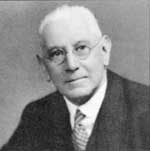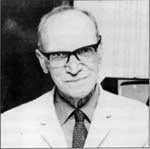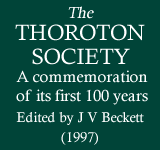The initial list of members of Council had been criticized at length in a letter to the Editor of the Nottingham Daily Guardian by an anonymous correspondent under the pseudonym ‘Antiquary’. He acknowledged their social influence, but commented on their lack of experience in historical and antiquarian research compared with some who had been ‘left out in the cold’ such as T.C. Hine, J.T. Godfrey, J. Ward and T.M. Blagg. In reply, ‘Patience’ stressed the importance of starting the Society on a sound financial basis and felt sure that the working antiquaries mentioned would in due time find places on Council. This proved to be correct, and after the first few years the ‘decorative’ members were gradually replaced by more active ones.
Thomas Matthew Blagg, a founder member, was elected to Council in 1901. By then he had already started his lifelong task of transcribing parish registers and calendaring wills. In 1903, aged 28. he became the youngest ever Fellow of the Society of Antiquaries. He was a frequent contributor to Transactions, as indeed was the non-attending chairman Lord Hawkesbury. In 1901 the draft of Hawkesbury’s paper on the families living at Osberton was accepted for publication. Hawkesbury, without consultation and while the copy was at the press, added twelve pedigrees, mostly large folding ones. When asked to contribute to the escalating cost of producing Transactions, he replied with a stiff letter to the effect that the Society should not embark on printing something it could not afford!
The regular series of lecture meetings which continues to the present day started in 1904. It had been suggested in 1901 that a lecture should be given at the Annual General Meeting, and although this duly took place in 1903 it did little to boost flagging attendance, which totalled only twenty-nine. Members were exceptionally parochial: a proposal in 1905 to visit Roche Abbey (about half a mile across the Derbyshire border) was opposed by T.M. Blagg. However, the organizers, the Rev. John Standish and W.H. Stevenson, hired a bottle-green 8 horse-power De Dion (which cost them two guineas for the day) for a planning trip, and took with them a flask of apricot brandy! The excursion went ahead. An appeal in 1906 to raise money for a suitable brass to be erected in Car Colston church in memory of Dr Thoroton raised only £39. The deficit was made up privately, but the perceived lack of enthusiasm from Society members explains the wording of the inscription: ‘erected by a few members of the Society’! It was rumoured at the time that some of the more aristocratic members of the Society considered that since Thoroton was ‘only a physician and historian’ and not a ‘gentleman’, a memorial was not really appropriate. It was, none the less, erected and an unveiling ceremony was held in September 1908.
The Society’s active interests extended into archaeology for the first time in 1908 with a dig at Beauvale Priory. £90 was raised by subscription to fund the dig, although the final cost was £98 17s 9d, partly because workmen were hired to do the manual work. The results were written up and published in Transactions for that year. The Society was also connected with Felix Oswald’s excavations at Margidunum, the Roman fort on the Fosse Way near Bingham, which began in 1910. After lecturing to the Society on his early work at the site, Oswald was made an honorary member. In 1969 an entire volume of Transactions was devoted to his and later Margidunum excavations.
In the early years the Society had no room of its own for meetings or to house a library. A room was rented in Bridlesmith Gate, Nottingham, in 1904, for £21 per annum, and the library was established, with James Ward, proprietor of a shoe shop on South Parade, as the first librarian. Ward was an avid book collector, who personally subsidized J.T. Godfrey to enable him to write books on the county, especially its churches. It was for this work that Godfrey was elected the first honorary member of the Society. Ward was followed as librarian by F.A. Wadsworth, who held the position for thirty-two years until his death in 1943. In 1909 the Society moved to a room on the ground floor of Bromley House, the home of the Nottingham Subscription Library on Angel Row. When, in about 1924, the ground floor was converted into shops, the Society moved up to the second floor, to rooms which it occupied until the 1970s. When it finally came, the decision to move from Bromley House after so many years was taken only after considerable debate and discussion in Council. However, the number of members using the library had declined and did not, it was felt, justify retaining the room. The books were transferred to the University of Nottingham and absorbed within the East Midlands Collection in the Hallward Library. Members of the Society have access and borrowing rights to the books.
Subscriptions went up in 1908 from 10s 6d to 12s 6d, enabling a larger volume of Transactions to be published. The first printers were Bells of Carlton Street; they were succeeded by Cooke and Vowles who, trading as ‘The Thoroton Press’, printed the Society’s publications for fifty years. Formans were responsible for six issues, and Derry & Son took over in 1955. They were succeeded by Technical Print Services in 1992.
During the First World War the winter lecture series continued, but excursions were limited to half days within easy reach of Nottingham. Some of the founding members died, including Standish in 1918. He had served as secretary from the beginning, although since 1906 he had assumed the role of editor with Fellows doing the secretarial work. Fellows resigned in 1920, and was succeeded by E.L. Guilford, who had been a lecturer in History at the University College, Nottingham since 1913. Guilford edited Transactions from 1925. He was a frequent contributor; indeed, his glossary of Nottinghamshire dialect appeared intermittently for over twenty years. Although Guilford left the University College in 1925 to take up a post with the BBC he continued to edit Transactions until 1937. He also edited a volume of the Nottingham Borough Records, and wrote several books on the history of the county.
 |
 |
| J. Holland Walker. | Keith Train |
J. Holland Walker and Keith Train, probably the two most influential figures in the Society between the 1920s and the 1980s. |
|
In 1925 John Holland Walker (1874-1960) became secretary, a position he held –for many years jointly with Alfred Parker – until 1957. Holland Walker was born in Yorkshire, but came to Nottinghamshire in childhood, and throughout his working life was associated with Dixon & Parker, the wholesale clothiers. His heart, however, lay not in business but in archaeology, architecture, and eccelesiology. He joined the Thoroton Society in 1911 and was elected to Council in 1921, but his scholarly activities were not confined to Nottinghamshire. He took part in the excavation of the Roman fort of Richborough in Kent, and was elected a Fellow of the Society of Antiquaries. As secretary of the Thoroton Society he succeeded in more than doubling the membership, and at his instigation some well known names were to be found among the list of lecturers. Holland Walker arranged excursions much further afield, lectured to the Society regularly, and wrote for the Transactions. Professor A.C. Wood wrote of his series ‘An Itinerary of Nottingham’, published over ten years, that ‘it is a safe prophecy that it will grow in significance and interest as time passes and as Nottingham’s topography continues to change’. Sixty years on, that prediction has proved entirely accurate. Holland Walker retired from the office at the age of 81. Wood, who knew him well – Professor W.R. Fryer later recalled that Wood especially enjoyed his meetings with Mr Holland Walker and other stalwarts of the "luncheon" club’ – wrote after his death that he
probably made a greater contribution to the work and prosperity of the Thoroton Society than any other individual member has done during the sixty-three years of its existence. Certainly, he was the outstanding and controlling figure in its progress... Under his inspiration and guidance the Society rose to unprecedented levels of success ...in large measure, the triumph of one man, and of the personality, the enthusiasm and the efficiency which he so readily devoted to the furtherance of the Society’s well-being.
He became, added Wood, ‘an institution and a legend’.[21]
For many years during Holland Walker’s tenure of office, and subsequently under following regimes, much of the work of the Society was carried out by Nora Witham (1908-84). In 1933 she was working as secretary to Mr Gustave Reddan, managing director of a Mansfield firm, when he became honorary treasurer of the Society. Subsequently she held a number of positions including, from 1953, excursion secretary, assistant secretary and assistant treasurer: in Keith Train’s words, ‘cheerfully undertaking many of the unglamorous but essential behind-the-scenes administrative duties so often taken for granted by the Society’s membership’.[22] She was made a vice president of the Society in 1982, but died shortly before the 1984 Annual Meeting. Her brother endowed an annual lecture which still bears her name and presented the Society with a gavel and block made from oak taken from the old Redhill Guide House.
In 1935 an Excavation Section of the Society was formed, reflecting members’ interests in archaeology. It published its first annual report in 1937, edited by Duncan Gray, the City Librarian, recording its work during the previous year. George Campion was its Director of Excavation; he had, as had his father, carried out archaeological work in the area for some years, and it was now felt that the work could with advantage be placed on a more formal basis under the auspices of the Thoroton Society. The Excavation Section had its own committee under the chairmanship of E.G. Underwood with W.H. Goddard as secretary. The report for 1936 records a membership of over 100 and a balance in the bank of £3 10s 11d.! It was a very active year: excavations at Nottingham Castle confirmed the positioning of the western outer wall and work was also carried out on the western passage area and the foundations of King Richard’s tower. Other sites dug during 1936 included the mound in the grounds of Lowdham Manor and, taking advantage of redevelopments in the city centre, Bridlesmith Gate, South Parade and Milton Street. Membership increased the following year and excavations revealed a Roman camp at Broxtowe. More work was carried out at the Castle and at various sites in the city centre. Subsequent years followed a similar pattern. In 1938 the section carried out preservation treatment on the dugout canoes which the Trent Navigation Company discovered when dredging near Clifton Grove. Inevitably work was curtailed by the outbreak of war and several members were called up for military service. Transactions of 1940 is the last to record among the officers of the Society the honorary secretary and the treasurer of the Excavation Section.
During the 1940s the Thoroton Excavation Section became the Nottingham Archaeological Society, although it continued to be affiliated to the main Society. It kept interest in archaeology alive throughout the war, and out of it grew, in 1949, the Peverel Research Group. Renamed the following year the Peverel Archaeological Group, this had some very active members including Harry Wildgoose, Geoff Mein, Bernard Beilby and Nancy Mulholland. Herbert Houldsworth was secretary. This group carried out some important excavations at Willoughby on the Wolds, Stoke Bardolph, Bridlesmith Gate (where the Anglo-Sakon ditch was revealed) and on the old Moot Hall site at the junction of Wheeler Gate and Friar Lane where an early fourteenth-century ‘tournament jug’ was found. This dark green glazed jug with well modelled horsemen and animals round its neck is now in the Castle Museum. Excavations were also carried out at the east end of Lenton Priory where pier bases were exposed, as were the east sides of the eastern piers of the central tower. The digs at this period were not without incident, and safety precautions were rudimentary. Being stuck in apertures in caves was one hazard; another occurred when a well flooded following the inadvertent breach of a large rainwater cistern in Fletcher Gate.
During 1959 a closer association between the Peverel Archaeological Group and the Thoroton Society was suggested; accordingly the two were merged as from 1 January 1960 and the Group became the Archaeological Section of the Society under the chairmanship of Stanley Revill, with Harry Wildgoose as secretary. Initially it held weekly meetings and was actively engaged with excavations at Stoke Bardolph medieval manor and at Thurgarton. In 1962 digs were carried out at Epperstone, Farnsfield and Lenton Priory. Nancy Mulholland became secretary. Excavations at Shelford occupied the Section from 1970-75. Interest in meetings of the Archaeological Section declined from 1970 onwards, as it did in excavation, with the increase in ‘professional’ digs. The committee ceased to exist, but for many years Nancy Mulholland as ‘Archaeological Correspondent’ maintained the link between the Society, the Council for British Archaeology, and the University of Nottingham’s Archaeological Department. She was a keen member of Council for thirty-six years.
